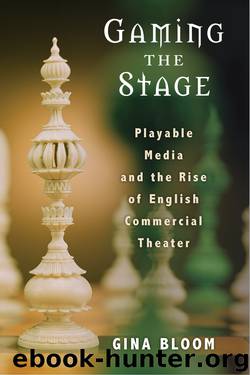Gaming the Stage: Playable Media and the Rise of English Commercial Theater by Gina Bloom

Author:Gina Bloom [Bloom, Gina]
Language: eng
Format: epub
Publisher: University of Michigan Press
Four. Chess
Performative History and Dynastic Marriage
Of all the sitting pastimes discussed in this book, chess is the one that may have been most frequently and certainly was most famously dramatized in the early modern theater—surprising, since it would seem the most difficult to stage. A card game, as we saw in Chapter 2, is well suited to theatrical performance because it offers theater spectators a similar perspective on the ludic action as onstage players and spectators: all have only partial access to information. Theatricalized chess, by contrast, offers radically different information to those on the stage and off. Whereas onstage players and spectators have equal visual access to the board, theater audiences cannot view the details of the board at all and so, unlike spectators of a regular chess game, they cannot play vicariously in the ways spectators of a card game might. When dramas stage chess, they capitalize on its status as a game of perfect information to solicit and sometimes frustrate theater spectators’ application of their knowledge of the game. Despite, or perhaps because of, these problems, chess works in complex ways as the setting for moments of revelation and concealment in dramatic literature. The game appears in at least eight plays written by well-known dramatists such as Chapman, Fletcher, Middleton, and Shakespeare, and it is often used to highlight plots of political maneuvering or intrigue. For instance, the pivotal scene in the plot of Middleton’s Women Beware Women, the Duke’s sexual assault of Bianca, is performed “above” in the theater’s balcony while Bianca’s unaware mother-in-law plays chess below with the Duke’s procuress. In Ford’s Love’s Sacrifice, the besotted Fernando finally confesses his illicit feelings for his Bianca during a chess game with her, while her jealous sister-in-law secretly watches.1
We often think of chess as a game about political strategy because of its narrative content—the pieces on the board representing kings, queens, knights, and so on—and certainly the game has long been part of the training of rulers.2 But theatrical stagings of chess reveal that its political content is conveyed less through the symbolism of its pieces than through the gameplay experience itself. In particular, I focus in this chapter on the temporal experience of chess play, which, I argue, can be politically seditious. Early modern staged chess scenes are exquisite sites for examining how the temporality of a chess game can stimulate the political imaginations of its players, actual and vicarious. My case studies are two dramas strongly associated with seventeenth-century English politics: Shakespeare’s The Tempest and Middleton’s A Game at Chess, the former being the most canonical early modern example of staged chess—one of the Bard’s most well-known plays—and the latter the most elaborate. A Game at Chess turns the theater stage into a chessboard with each of the play’s characters embodying a different chess piece: White Queen, Black Bishop, and so on.
It is in part because of their associations with Jacobean politics that The Tempest and A Game at Chess beg to be singled out among the many early modern plays that dramatize chess.
Download
This site does not store any files on its server. We only index and link to content provided by other sites. Please contact the content providers to delete copyright contents if any and email us, we'll remove relevant links or contents immediately.
| Ancient & Classical | Arthurian Romance |
| Beat Generation | Feminist |
| Gothic & Romantic | LGBT |
| Medieval | Modern |
| Modernism | Postmodernism |
| Renaissance | Shakespeare |
| Surrealism | Victorian |
4 3 2 1: A Novel by Paul Auster(12333)
The handmaid's tale by Margaret Atwood(7712)
Giovanni's Room by James Baldwin(7258)
Asking the Right Questions: A Guide to Critical Thinking by M. Neil Browne & Stuart M. Keeley(5712)
Big Magic: Creative Living Beyond Fear by Elizabeth Gilbert(5682)
Ego Is the Enemy by Ryan Holiday(5351)
The Body: A Guide for Occupants by Bill Bryson(5034)
On Writing A Memoir of the Craft by Stephen King(4893)
Ken Follett - World without end by Ken Follett(4688)
Adulting by Kelly Williams Brown(4536)
Bluets by Maggie Nelson(4515)
Eat That Frog! by Brian Tracy(4484)
Guilty Pleasures by Laurell K Hamilton(4395)
The Poetry of Pablo Neruda by Pablo Neruda(4068)
Alive: The Story of the Andes Survivors by Piers Paul Read(4001)
White Noise - A Novel by Don DeLillo(3982)
Fingerprints of the Gods by Graham Hancock(3966)
The Book of Joy by Dalai Lama(3947)
The Bookshop by Penelope Fitzgerald(3812)
